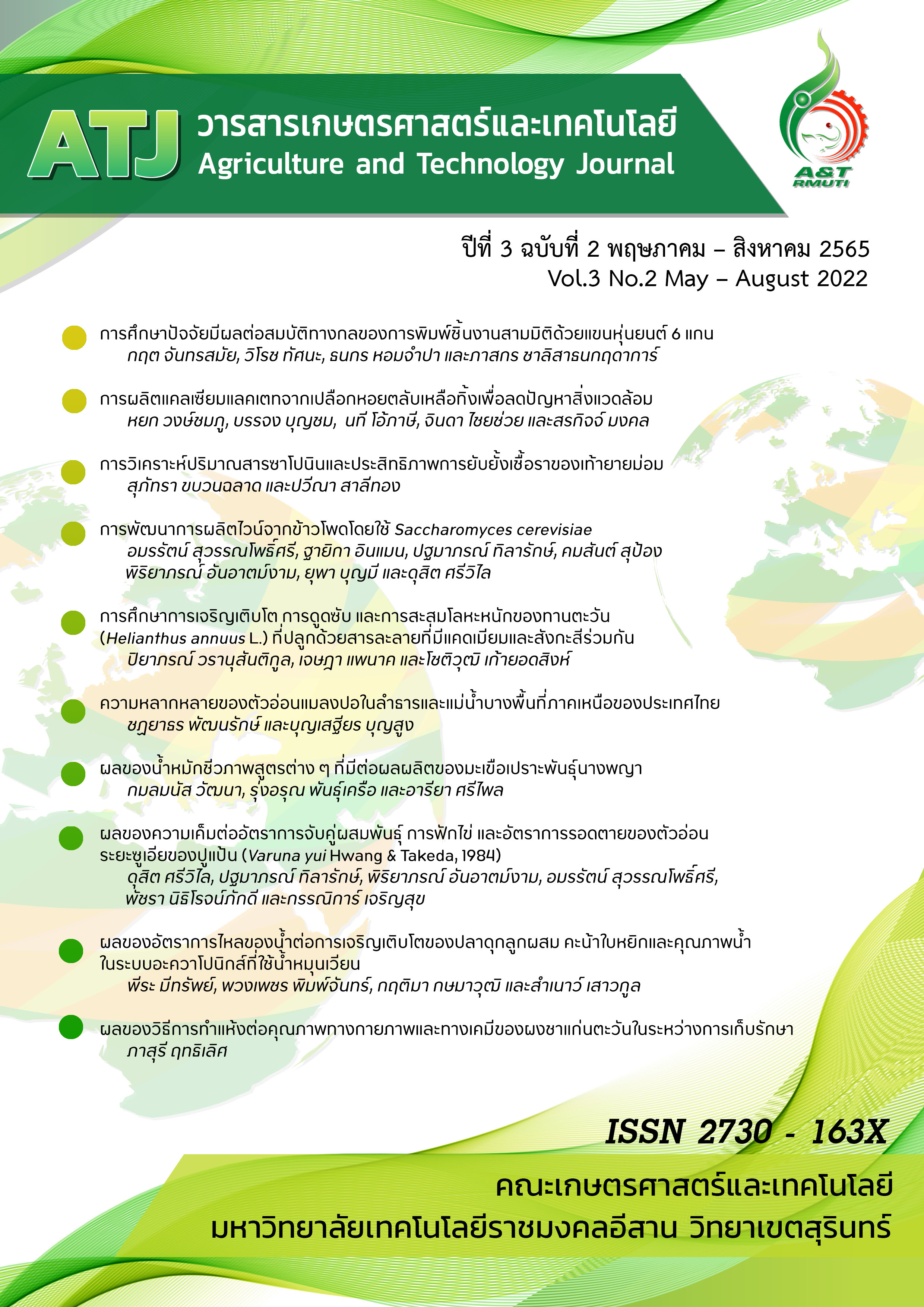การศึกษาปัจจัยมีผลต่อสมบัติทางกลของการพิมพ์ชิ้นงานสามมิติด้วยแขนหุ่นยนต์ 6 แกน
The study of factors affecting mechanical properties of 3D printing with 6-axis robotic arm
คำสำคัญ:
การผลิตแบบเพิ่มเนื้อวัสดุ, การพิมพ์สามมิติ, หุ่นยนต์แขนกล , การออกแบบการทดลองแบบทากูชิบทคัดย่อ
งานวิจัยนี้มีวัตถุประสงค์เพื่อศึกษาการสร้างระบบการพิมพ์ชิ้นงานสามมิติด้วยแขนหุ่นยนต์ 6 แกน ด้วยระบบป้อนเส้นใยพลาสติกชนิด ABS ที่ควบคุมผ่านโปรแกรมเมเบิลลอจิกคอลโทรลเลอร์ โดยศึกษาตัวแปรที่มีผลต่อสมบัติทางกลของเปอร์เซ็นต์การยึดตัวของพลาสติกที่พิมพ์ขึ้นด้วยวิธีการออกแบบการทดลองแบบทากูชิ (Taguchi) สำหรับออร์ทอกอนัลแอร์เรย์แอล 9 (33) โดยมีปัจจัยควบคุม 3 ตัวแปร 3 ระดับ คือ สัญญาณพัลส์ 180, 190, 200 และระยะห่างระหว่างเส้นใยพลาสติก 0.9, 1.0, 1.1 มิลลิเมตร และอุณหภูมิหลอมละลายเส้นใยพลาสติก 190, 200, 210 องศาเซลเซียส จากผลการทดลองพบว่า ผลลัพธ์ของปัจจัยที่เหมาะสมโดยพิจารณาจากระดับอัตราส่วนสัญญาณต่อสิ่งรบกวน (Signal to-Noise Ratio; S/N) ที่ค่าเฉลี่ยสูงสุด คือ สัญญาณพัลส์ 200 และระยะห่างระหว่างเส้นใยพลาสติก 0.9 มิลลิเมตร และความร้อนสำหรับการละลายเส้นใยพลาสติก 210 องศาเซลเซียส และมีค่าเปอร์เซ็นต์การยืดตัวมากที่สุดอยู่ที่ 3.422%
เอกสารอ้างอิง
Ahmad M.N., Rahman M.H.B.A. and Maidin N.A. (2019). Optimization on surface roughness of fused deposition modelling (FDM) 3D printed parts using Taguchi approach. Lecture Notes in Mechanical Engineering. Chapter: Intelligent Manufacturing and Mechatronics. Publishing: Springer Nature. 230-243.
Carabina G., Scalera L., Wongratanaphisanb T. and Vidonia R. (2021). An energy-efficient approach for 3D printing with a Linear Delta Robot equipped with optimal springs. Robotics and Computer-Integrated Manufacturing. 67:102045.
Lan L., Jianping S., Kaiwei M., Jing J., Peng W., Huixin L., Yi C., Xingsong W. and Qing J. (2021). Robotic in situ 3D bio-printing technology for repairing large segmental bone defects. Journal of Advanced Research. 30: 75-84.
Luan X.Y., Chengzhe L., Liujian L. and Jianzhong F. (2018). Self-monitoring continuous carbon fiber reinforced thermoplastic based on dual material three-dimensional printing integration process. Carbon. 140: 100-111.
Moza Z., Kitsakis K., Kechagia J. and Mastorakis N. (2015). Optimizing dimensional accuracy of fused filament fabrication using Taguchi design. Recent Researches in Electrical and Computer Engineering. June 2015: 110-114.
Munproma R. and Limtasiri L. (2019). Optimization of stereolithographic 3D printing parameters using Taguchi method for improvement in mechanical properties. Materials Today: Proceedings. 17: 1768–1773.
Parandoush P. and Lin. D. (2017). A review on additive manufacturing of polymer-fiber composites. Composite Structures. 182: 36-53.
Tan J. C. and Low H. Y. (2018). Embedded electrical tracks in 3D printed objects by fused filament fabrication of highly conductive composites. Additive Manufacturing. 23: 294-302.
Thasana W., Kaewdook D., Khantiyanuwat P., Boonsiri N. and Yoshida Y. (2015). Study of 3D Printer for Educational Use, paper presented in the 6th TSME International Conference on Mechanical Engineering (ICoME 2015), 16-18 December 2015, Phetchaburi, Thailand.
Tim A., Osswald J. P. and Kattinger J. (2018). Fused filament fabrication melting model. Additive Manufacturing. 22: 51-59.
ดาวน์โหลด
เผยแพร่แล้ว
เวอร์ชัน
- 19-02-2024 (2)
- 30-08-2022 (1)
รูปแบบการอ้างอิง
ฉบับ
ประเภทบทความ
สัญญาอนุญาต
ลิขสิทธิ์ (c) 2022 วารสารเกษตรศาสตร์และเทคโนโลยี

อนุญาตภายใต้เงื่อนไข Creative Commons Attribution-NonCommercial-NoDerivatives 4.0 International License.
เนื้อหาและข้อมูลในบทความที่ลงตีพิมพ์ในวารสารทดสอบระบบ ThaiJo2 ถือเป็นข้อคิดเห็นและความรับผิดชอบของผู้เขียนบทความโดยตรงซึ่งกองบรรณาธิการวารสาร ไม่จำเป็นต้องเห็นด้วย หรือร่วมรับผิดชอบใดๆ
บทความ ข้อมูล เนื่อหา รูปภาพ ฯลฯ ที่ได้รับการดีพิมพ์ในวารสารทดสอบระบบ ThaiJo2 ถือเป็นลิขสิทธิ์ของวารสารทดสอบระบบ ThaiJo2 หากบุคคลหรือหน่วยงานใดต้องการนำทั้งหมดหรือส่วนหนึ่งส่วนใดไปเผยแพร่หรือเพื่อกระทำการใดๆ จะต้องได้รับอนุญาตเป็นลายลักอักษรณ์จากวารสารทดสอบระบบ ThaiJo2 ก่อนเท่านั้น







